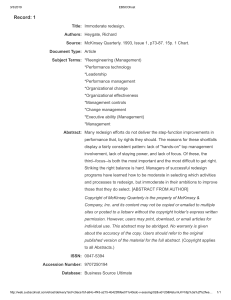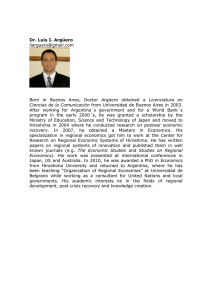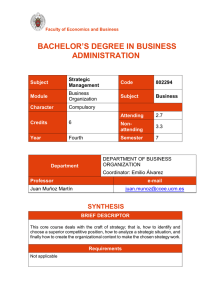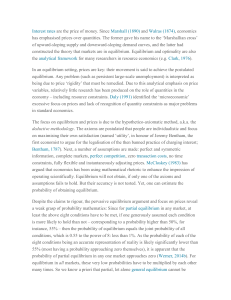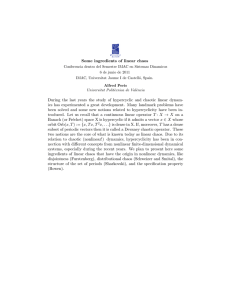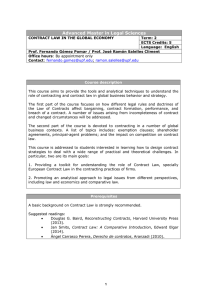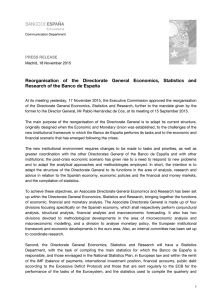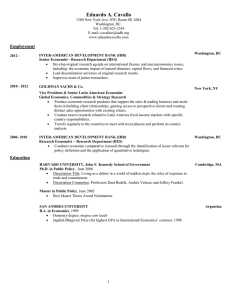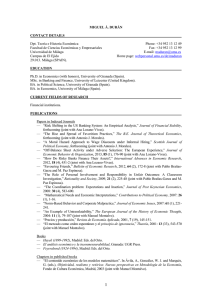LR1-McKinsey ERIC BEINHOCKER Strategy at the edge of chaos
Anuncio
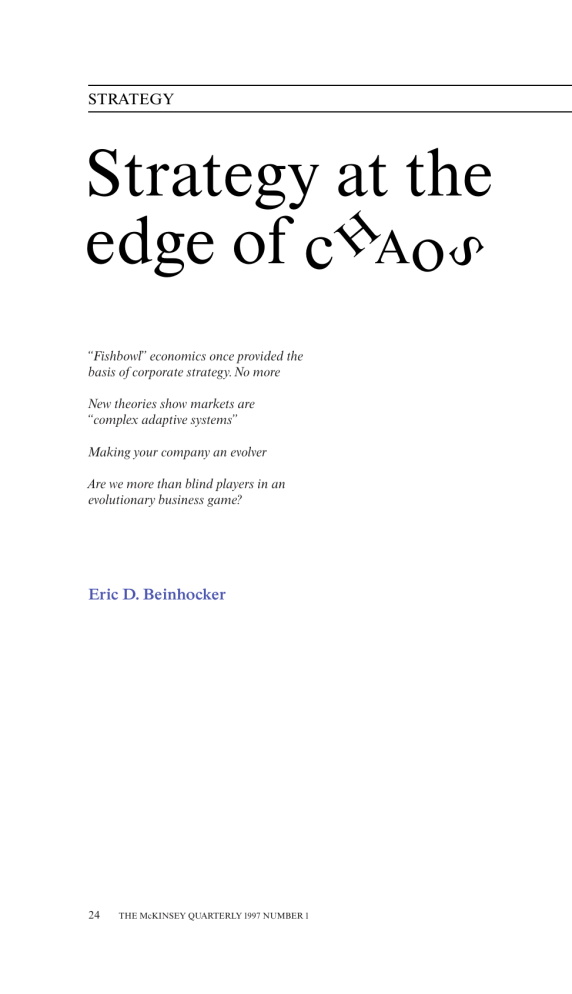
STRATEGY s Strategy at the edge of c HAo “Fishbowl” economics once provided the basis of corporate strategy. No more New theories show markets are “complex adaptive systems” Making your company an evolver Are we more than blind players in an evolutionary business game? Eric D. Beinhocker 24 THE McKINSEY QUARTERLY 1997 NUMBER 1 that there are three types of economics. There are up-and-down economics (“stocks were up and unemployment was down today”), airport-bookstore economics (Ten Easy Steps to Avoid Global Depression), and Greek-letter economics. Greekletter economics is the mathematical variety practised in universities and published in academic journals. And it is in serious trouble. T HE ECONOMIST PAUL KRUGMAN SAYS Historically, Greek-letter economics has rewarded mathematical pyrotechnics over fidelity to the real world. The core theories it has produced over the last few decades, such as rational expectations and general equilibrium, are mathematically elegant, but lacking in empirical validity. Joseph Stiglitz, chairman of the US President’s Council of Economic Advisors, recently observed, “Anybody looking at these models would say they can’t provide a good description of the modern world.”* The dismal state of the dismal science matters to managers, CEOs, consultants, and business professors because much of modern thinking in management is built on a foundation of Greek-letter economics. The bad news is that this foundation is now in serious doubt; the good news is that a radically new one is starting to be put in place. Though the term paradigm shiƒt is overused, the changes currently taking shape in economics justify the use of the phrase Thomas Kuhn coined to describe how scientific fields enter a state of crisis and then move to a completely new way of thinking, as with the shiƒt from Newtonian to Einsteinian physics. The new approach to economics has important implications for management, and in particular for strategy and organization. Although it is still in its infancy, we can begin to see how it might help us gain fresh insights into a host of diƒficult questions. Why do industries that look stable suddenly get turned upside down? How can companies develop strategies in the face of uncertainty? Why are big companies that seem to have it all so oƒten vulnerable to attack by small upstarts? Let’s begin by considering where traditional thinking on management comes from, and how it is based on a central metaphor that originated in physics and was adopted by economics. I would like to thank Kevin Coyne, Oliver Engert, Dick Foster, Rainer Gawlick, John Hagel, Somu Subramaniam, George Ugras, and my colleagues in the McKinsey Strategy Forum/Strategy Theory Initiative for their contributions to this article. I also benefited from the writings of, and discussions with, Brian Arthur, Larry Blume, Steven Durlauf, David Lane, and Stuart Kauƒfman of the Santa Fe Institute. * Quoted in John Cassidy, “The decline of economics,” New Yorker, December 2, 1996, p. 56. Eric Beinhocker is a consultant in McKinsey’s Washington, DC oƒfice. Copyright © 1997 McKinsey & Company. All rights reserved. THE McKINSEY QUARTERLY 1997 NUMBER 1 25 STRATEGY AT THE EDGE OF CHAOS The roots of management thinking Many of the most successful and widely used strategy tools today – the five forces framework, cost curves, the structure-conduct-performance (SCP) model, and the concept of sustainable competitive advantage, to name a few – owe their origins to ideas developed in the 1950s in a field known as the theory of industrial organization. IO theory, which is concerned with industry structure and firm performance, is in turn based on microeconomic theory. Modern neoclassical microeconomics was founded in the 1870s by Leon Walras, William Stanley Jevons, and Carl Menger, and synthesized into a coherent theory by Alfred Marshall at the turn of the century. Seeking to make economics more scientific, Walras, Jevons, and Menger had borrowed ideas and mathematical apparatus from the leading science of their day, energy physics. Twenty years earlier, Julius Mayer, James Prescott Joule, Hermann von Helmholtz, and Ludwig August had achieved breakthroughs in energy physics that paved the way for thermodynamics. The early neoclassicists copied the mathematics of mid-nineteenth-century energy physics equation by equation, translating it metaphorically (and, according to many physicists, Closed equilibrium systems incorrectly) into economic concepts. are the core metaphor of much of our management thinking Another neoclassicist, Irving Fisher, showed in his 1892 doctoral thesis how the physicists’ “particle” became the economists’ “individual,” “force” became “marginal utility,” “kinetic energy” became “total expenditure,” and so on. Although microeconomic theory has undergone many changes over the past century, the core ideas developed by Alfred Marshall, Irving Fisher, and the other early neoclassicists still resonate in economics textbooks today.* Here can be found the roots of management’s family tree, from Mayer and early thermodynamics through Marshall and microeconomics to Michael Porter and the five forces model of strategy. This intellectual lineage still aƒfects the way we approach management today. Equilibrium systems The Argentinian writer Jorge Luis Borges observed, “It may be that universal history is the history of a handful of metaphors.” The mid-nineteenth-century energy physicists developed what may be one of the great metaphors of all time: that of closed equilibrium systems. Closed equilibrium systems are the core metaphor of Alfred Marshall’s traditional economics and of much of our management thinking today. * For an account of the interwoven history of economics and physics, see Philip Mirowski, More Heat than Light: Economics as social physics, physics as nature’s economics, Cambridge University Press, Cambridge, 1991. 26 THE McKINSEY QUARTERLY 1997 NUMBER 1 STRATEGY AT THE EDGE OF CHAOS Consider a ball at the bottom of a bowl. If no energy or mass enters or leaves the bowl – that is, the system is closed – the ball will sit in equilibrium at the bottom of the bowl for ever. In economic terms, the sides of our bowl represent the structure of a market (for instance, producer costs and consumer preferences), and the gravity that pulls the ball to its lowest energy state represents profit-seeking behavior pulling firms to their highest profit state. If we know the economic forces at work, and if firms are rational, we can predict where the ball will come to rest in the bowl – in other words, the prices, quantities produced, and profitability of firms under equilibrium. If some exogenous shock now hits the system (say a technology shiƒt alters producer costs), the sides of the bowl change shape, and the ball rolls to a new point of equilibrium (Exhibit 1). Exhibit 1 Equilibrium systems The ball rests at its lowest energy state in equilibrium. An exogenous shock unsettles the system… …and reshapes the bowl, creating a new equilibrium. This sequence of equilibrium–change a variable–new equilibrium is what economists call comparative statics, and forms the underpinning of Alfred Marshall’s economics and most business strategy. In a typical strategy analysis, a company will look at its position in the current industry structure, consider the shocks and changes that are occurring or might occur, and then develop a point of view on how the industry is likely to change and what that will mean for its own strategy. Such an approach makes three important assumptions: that the industry structure is known, that diminishing returns apply, and that all firms are perfectly rational. But what happens if rapid technological or business-system innovation makes producer costs and consumer preferences uncertain? What if we face not diminishing returns (where each additional acre of soybean planted is on poorer land and thus yields a lower return), but increasing returns (where each extra Netscape browser sold increases the value of the World Wide Web and thus yields a higher return)?* What if firms lack complete information, or diƒferent firms interpret the same information in diƒferent ways? * For a more detailed discussion of increasing returns, see W. Brian Arthur, “Positive feedbacks in the economy,” The McKinsey Quarterly, 1994 Number 1, pp. 81–95, and “Increasing returns and the new world of business,” Harvard Business Review, July–August 1996, pp. 100–9. THE McKINSEY QUARTERLY 1997 NUMBER 1 27 STRATEGY AT THE EDGE OF CHAOS If the fundamental assumptions underlying the equilibrium model are relaxed, the eƒfect on the ball in the bowl will be dramatic. The sides of the bowl start to bend and flex, losing their smooth shape and becoming a landscape of hills and valleys, and the ball can no longer tell which way is up. Now it is impossible to predict where the ball will roll, and Alfred Marshall loses his equilibrium. But this is not merely a theoretical problem, since the ball-in-the-bowl equilibrium model is the basis for our strategy ideas. Marshall’s equilibrium model was a reasonable approximation to the agricultural and manufacturing economy of his time, and it is still useful in many situations. But it runs into trouble in today’s dynamic high-tech and service-dominated economy. Consider a company that plans to invest heavily in What’s needed is a model entering a new market. It faces strong inof a world where innovation, cumbents that enjoy a host of competitive change, and uncertainty are advantages such as scale and brands, and the natural state of things that already compete fiercely with each other. Moreover, its own value proposition, while distinct from competitors’, can easily be copied. In short, the entrant has no obvious source of sustainable competitive advantage. Any observer taking a traditional view of strategy would surely question the sanity of making this investment. But what if the entrant were CNN? Dell Computer? Wal-Mart? Or IKEA? All these companies succeeded in spite of what the traditional model of strategy would perceive as long odds. They all violated the closed-equilibrium assumptions at the heart of this model. They innovated in products and/or business systems, took advantage of increasing returns dynamics, and had mental models of their industry that were radically diƒferent from those of incumbent competitors. One might use traditional strategy frameworks to explain the success of these companies retrospectively, but it is oƒten much harder to use them to look forward in industries undergoing rapid change. A Porter or SCP analysis will be of only limited help to, say, a telecom CEO facing deregulation, profound technological change, industry convergence, globalization, and increasing returns in sectors like the Internet and wireless. What this CEO needs is a model of a world where innovation, change, and uncertainty, rather than equilibrium, are the natural state of things. Complex adaptive systems Anthills are marvellous things. With elaborate labyrinths of tunnels, layouts reflecting their occupants’ social hierarchies, chambers dedicated to specific functions, and carefully sited entrances and exits, they are as thoughtfully 28 THE McKINSEY QUARTERLY 1997 NUMBER 1 STRATEGY AT THE EDGE OF CHAOS constructed as any condominium complex. Yet who is the engineer? Where is the blueprint? The answer, of course, is that there isn’t one. The plan for the anthill does not exist in any individual ant. Rather, each ant is programmed by its DNA to obey a set of relatively simple rules, such as “stand between two other ants and pass along anything that is handed to you.” Ants communicate with each other via chemical signals known as pheromones. These signals provide inputs and outputs for the rules, and switch them on and oƒf. It is the dynamic interaction of the rules and signals that creates the anthill structure. The community of ants is an example of a complex adaptive system. Such systems share three key characteristics: First, they are open, dynamic systems. The Marshall ball-in-a-bowl system is closed; no energy or mass enters or leaves, and the system is able to settle into an equilibrium state. By contrast, a complex adaptive system is always open, and the energy and mass that constantly flow through it keep it in dynamic disequilibrium. An anthill is a perpetual-motion machine in which patterns of behavior are constantly shiƒting; some patterns appear stable, others chaotic. Second, they are made up of interacting agents. These agents might be ants, people, molecules, or computer programs. Systems that have one agent – say, a monopoly model in economics, or a body in motion in physics – tend to be fairly simple and predictable. Similarly, systems that have multitudes of agents that are all the same – as with perfect competition in economics, or gases in physics – are also simple and predictable. But systems that have somewhere between one and a multitude of agents, or systems where the agents are all different, such as real-world business markets, are complex and diƒficult to predict. This complexity derives from the dynamic interactions of the agents: what each agent does aƒfects one or more others, at least some of the time. The interactions of agents in a complex system are guided by rules: laws of physics, codes of conduct, or economic imperatives such as “cut price if your competitor does.” If the repertoire of rules is fixed, the result is a complex system. If the rules are evolving, as with genes encoded in DNA or the strategies pursued by players in a game, the result is a complex adaptive system. Third, complex adaptive systems exhibit emergence and self-organization. As individuals, ants don’t do much. But put them in a group where they can interact and an anthill emerges. Because the anthill rises out of the bottomup dynamic interactions of the ants and not from a top-down master plan, it is said to self-organize. The emergent structure is independent of specific agents. Individual ants may come and go, but the pattern of the anthill persists. THE McKINSEY QUARTERLY 1997 NUMBER 1 29 STRATEGY AT THE EDGE OF CHAOS Other examples of complex adaptive systems include cities, forest ecosystems, the immune system, and the Internet. All are open systems comprising a number of agents whose dynamic interactions self-organize to create a larger structure. Over the past twenty years, aided by advances in mathematics, physics, chemistry, and biology and by the wide availability of cheap computing power, scientists have begun to find that complex adaptive systems are governed by deep common laws. Just as the laws of statistics can help us understand such ostensibly diƒferent systems as a poker game and the spread of disease in a population, the laws of complexity may yield new insights into problems ranging from the origins of life to traƒfic jams in LA. The new economics To managers, this should be more than just interesting science. A number of economists are beginning to say that economies are complex adaptive systems, rather than the closed equilibrium systems they have long been thought to be. The case has yet to be proven, but there is both circumstantial evidence and support from some eminent economists, among them Kenneth Arrow, a Nobel Prize winner and one of the prime architects of the modern neoclassical model, and Brian Arthur of the Santa Fe Institute. Indeed, the new economics is sometimes referred to as the Santa Fe school of economics aƒter the interdisciplinary research center to which many economists working on ideas of complexity are aƒfiliated. Past attempts by academics and popular business gurus to take an evolutionary or biological view of economic systems have mostly been metaphorical, and have failed. By contrast, the complexity economists are saying not just that economies are like biological systems, but that the two spheres follow the same deep laws. To be sure, these laws will not play out in quite the same way in economies and in biology, but if we can improve our understanding of them, we will gain valuable insights into the workings of markets and firms. A new economics based on complex adaptive systems is still in its infancy, but enough work has been done to suggest what the key components might be: Wisdom. First, the new economics will be based on a realistic model of cognitive behavior. Traditional economics assumes that people are alike in their thought processes (though their preferences may diƒfer), and that they make choices as if they were solving complicated deductive equations that enabled them to make the best possible decisions. Economists have long realized that these assumptions are an oversimplification, but they were needed to make the math work for the ball-in-the-bowl model. Computer simulation techniques and advances in cognitive science now allow us to make much more realistic assumptions. 30 THE McKINSEY QUARTERLY 1997 NUMBER 1 STRATEGY AT THE EDGE OF CHAOS Cognitive scientist Andrew Clark of Washington University has a saying: “Humans are bad at logic, but good at frisbee.” What he means is that people are poor at the deductive logic that is assumed in traditional economic models, but skilled at recognizing patterns and developing inductive rules of thumb by learning from their experience. Induction allows us to make decisions quickly in the face of incomplete and changing information, but it also means that even though we are rational, we do not always make optimal decisions. Moreover, people with the same information may arrive at diƒferent decisions because of diƒferences in their past experience. Although a new model of economic decision making has not yet been completed, early work suggests that replacing perfect rationality with more realistic assumptions of inductive decision making produces new insights and diƒferent strategic recommendations. Webs. Second, the new economics will see agents as interacting with one another in a dynamic web of relationships. Sun Microsystems’ old advertising slogan was “The network is the computer” – an assertion that might also hold true for Traditional economics has never complex systems. Put a bunch of ants, combeen able to explain innovation panies, or stock traders together in a comand growth, except as the result munications network and you get all sorts of random exogenous shocks of intricate self-organized behavior. In the new economics, it will not be enough to have a sound model of a firm’s behavior; we must also know how people interact within it, how it interacts with other firms in its market, and how these interactions change over time. Waves. Third, markets will be viewed as inherently dynamic rather than static systems. When adaptive agents interact in a web of relationships, evolutionary changes in one agent will aƒfect the evolution of others. This eƒfect, known as co-evolution, is frequently seen in nature, and also occurs in economics when an innovation (such as the invention of the automobile) produces ripple eƒfects throughout the whole economy (the development of the oil industry, motels, the growth of suburbs, and so on).* Traditional economics has never been able to explain innovation and growth, except as the result of random exogenous shocks from technology. As Harvard economist Greg Mankiw remarked, “We say it’s technology, and that’s what you say when you don’t understand something.”† A new economics based on complexity will help us gain insights into the endogenous evolutionary forces that drive Schumpeter’s waves of “creative destruction” through an economy. ≠ See Stuart A. Kauƒfman, “Technology and evolution: Escaping the Red Queen eƒfect,” The McKinsey Quarterly, 1995 Number 1, p. 126. ≤ Quoted in John Cassidy, “The decline of economics,” New Yorker, December 2, 1996, p. 52. THE McKINSEY QUARTERLY 1997 NUMBER 1 31 STRATEGY AT THE EDGE OF CHAOS Would-be worlds. Not only will the substance of economics be transformed, but so too will its research techniques. Traditional economics uses mathematical proofs to model its theories. The benefit of this approach is that you can be confident of the logical rigor of your answer. The drawback is that proofs restrict you to simple assumptions such as perfect rationality. No matter how elegant or rigorous the model is, if the assumptions do not reflect the real world, the answer will be irrelevant. Though the new economics will continue to make use of proofs, it will increasingly turn to sophisticated computer simulations based on more realistic assumptions. In agent-based models, for example, a company can be modeled as an intelligent computer program capable of learning and adapting. You can put a bunch of these programs into a simulated competitive market, unleash the forces of evolution on them, and watch diƒferent futures unfold. Brian Arthur calls this type of research “doing economics in a computer petri dish.” John Casti, also of the Santa Fe Institute, describes these evolutionary simulations as “would-be worlds.”* Although such models are likely to be of little help in forecasting the precise path an industry might take, since complex systems can be diƒficult or impossible to forecast, they will be valuable in fostering insights into how and why markets behave as they do. Early thinking on management Change Although the new economics is very much a work in progress – we are still waiting for our Alfred Marshall – it has advanced far enough for us to begin to think about its implications for strategy and organization. To be sure, such thoughts are still preliminary hypotheses that will be proven, expanded, or abandoned as the new complexity-based economExhibit 2 ics develops. However, they suggest ways in which Punctuated equilibrium complexity thinking may confirm, build on, or overPunctuation points turn many traditional ideas in management. One characteristic of complex adaptive systems is punctuated equilibrium (Exhibit 2). This occurs when times of relative calm and stability are interrupted by stormy restructuring periods, or punctuation Time points. Punctuated equilibrium can be seen in phenomena ranging from the mass speciations and extinctions of the fossil record to the booms and busts of the stock market. These storms are not necessarily caused by random external events – a comet Stasis ≠ See John L. Casti, Would-Be Worlds: How simulation is changing the frontiers of science, John Wiley, New York, 1997. 32 THE McKINSEY QUARTERLY 1997 NUMBER 1 STRATEGY AT THE EDGE OF CHAOS wiping out the dinosaurs, or bad news triggering a stock fall – but are a natural endogenous feature of the evolutionary process. Punctuated equilibrium makes it diƒficult for participants to survive for long periods, as their strategies and skills tend to get finely optimized for the stable periods and then suddenly become obsolete when the inevitable restructuring takes place. Similarly, companies have a hard time surviving the upheavals, shakeouts, and technology shiƒts that punctuate the evolution of markets. Dick Foster, a director at McKinsey, observes that “Companies don’t innovate; markets do.” In other words, the evolution of markets is driven more by the entry and exit of firms than by any dramatic changes within As new entrants thrive and incumbent players. incumbents decline, markets constantly and unsentimentally remake themselves It wasn’t dominant established retailers like Sears that created category killer stores or booming mail-order businesses, despite the fact that Sears actually invented the catalog over a century ago; rather, it was aggressive entrants like The Home Depot, Circuit City, and Lands’ End. Similarly, it wasn’t IBM that pioneered the minicomputer, the workstation, the desktop computer, or the widespread use of the Internet, but rather new entrants DEC, Sun, Apple, and Netscape. Though Sears and IBM have survived these shiƒts, they have been less dynamic than the markets in which they participate, and their performance has suƒfered during each transition. Despite the diƒficulty individual companies experience in making major shiƒts, markets perform such jumps quite easily. As new entrants thrive and incumbents decline, markets constantly and unsentimentally remake themselves. To prosper in the long run, a company must be as good at evolving as its market, or better. More specifically, it must be both a strong competitor in the current regime and a smart evolver, able either to innovate ahead of the market or to adapt with it. Historically, the equilibrium view of strategy has focused on how to be a good competitor, not a good evolver. There are tensions and tradeoƒfs between the two. Yet the most successful companies do not simply strike a middle ground, but manage to excel at competing and evolving simultaneously, despite the tensions. To clarify this point, let us consider five critical aspects of being a good evolver. Focused versus robust strategies Traditional strategy tends to emphasize a focused single line of attack – a clear statement of where, how, and when to compete. In a complex adaptive system, a focused strategy to dominate a niche is necessary for day-to-day survival, but not suƒficient in the long run. Given an uncertain environment, THE McKINSEY QUARTERLY 1997 NUMBER 1 33 STRATEGY AT THE EDGE OF CHAOS strategies must also be robust – that is, able to perform well in a variety of possible future environments. One company that has managed to be both focused and robust is Microsoƒt. In the late 1980s, with DOS coming to the end of its useful life, Bill Gates focused on moving the industry to another Microsoƒt product, Windows. Appreciating the uncertainty of this punctuation point, however, he hedged his bet by also investing in Windows’ competitors: Unix, OS/2, and the Apple Macintosh system. In addition, his company developed deep generic skills in object-oriented programming and graphical interface design – skills that would be useful no matter which system won, even if it were a complete unknown. Gates’s approach of pursuing several paths simultaneously is intrinsically diƒficult to manage. He was accused in the press of not having a strategy and confusing customers, and it is easy to imagine that there were internal tensions within Microsoƒt as well. Being robust calls for the ability to pursue a package of potentially conflicting strategies at the same time. Such a package might include big shaping bets (such as Windows), hedges (support of OS/2), and no-regrets moves that are valid regardless of outcome (building object-oriented programming skills). A robust package of strategies can be thought of as a portfolio of real options, and just as with financial options, the greater the uncertainty, the greater their value. Robust strategy diƒfers from traditional scenario analysis in that it does not presuppose an ability to identify the most or least likely outcomes. Rather, it echoes Francis Crick, one of the discoverers of DNA and the formulator of Orgel’s Second Rule (named aƒter his colleague Leslie Orgel – no one is quite sure what the First Rule was), which states, “Evolution is cleverer than you are.” Robust strategy makes a company more like a market, with a population of strategies that cover a broad array of possibilities and evolve over time, some succeeding and some failing. Competitive advantage versus continuous adaptation Evolutionary systems exhibit a phenomenon known as the Red Queen eƒfect aƒter that character’s remark in Through the Looking Glass: “It takes all the running you can do to keep in the same place.”* In nature, the Red Queen eƒfect is at work when a predator learns to run faster, its prey responds by acquiring better camouflage, the predator then develops a better sense of smell, the prey starts to climb trees, and so on. For players locked in a Red Queen race, competitive advantage, that pillar of traditional strategic ≠ See Stuart A. Kauƒfman, “Technology and evolution: Escaping the Red Queen eƒfect,” The McKinsey Quarterly, 1995 Number 1, pp. 118–29. 34 THE McKINSEY QUARTERLY 1997 NUMBER 1 STRATEGY AT THE EDGE OF CHAOS thinking, is simply not sustainable. Instead, success comes to those who keep changing their position to stay one step ahead. Exhibit 3 The Red Queen effect Total return to shareholders Industry mean 1 2 3 4 5 1 2 Years If advantage was sustainable, some companies would be expected to sustain superior performance. 3 4 5 Years Instead, a study of 400 companies over 30 years shows that high performers regress to the industry mean after 3–7 years. 1 5 10 15 20 Years Although companies do not sustain advantage, a few seem to create new advantages continually. Evidence suggests that the business world resembles a Red Queen race. A study of the performance of more than 400 companies over thirty years reveals that firms find it diƒficult to maintain higher performance levels than their competitors for more than about five years at a time (Exhibit 3). Advantage tends to be competed away quite quickly. Long-term superior performance is achieved not through sustainable competitive advantage, but by continuously developing and adapting new sources of temporary advantage, and thus being the fastest runner in the Red Queen race. Conservative operator versus radical innovator Fitness In a complex adaptive system, an agent that is resistant to change and not adaptable will have low fitness. Conversely, an agent that is oversensitive to shiƒts in its environment and Exhibit 4 constantly making radical The edge of chaos responses will also have low fitness. But between these extremes of stasis and chaos lies a region where fitness is maximized – the edge of chaos (Exhibit 4). Being at the edge of chaos does not mean pursuing a moderate level of change, but someStasis Edge of chaos Chaos thing more subtle. At the edge of chaos, one is simulSlow, incremental change Rapid, radical change taneously conservative and radical. THE McKINSEY QUARTERLY 1997 NUMBER 1 35 STRATEGY AT THE EDGE OF CHAOS Evolution is adept at keeping things that work while at the same time making bold experiments. The morphology of the spinal cord is a robust adaptation that has survived eons of evolution and massive environmental shiƒts. Yet nature has experimented wildly around this core idea, producing vertebrates that range from birds to whales to humans. The Walt Disney Company is a firm that prospers at the edge of chaos. Its theme parks and other businesses are run in a deeply conservative fashion. A strong culture supports Disney’s mission of providing family entertainment. In operations, no detail is too small, right down to the personal grooming of the parking-lot attendants. This culture is ingrained in the organization and constantly If there were a wide variety reinforced through management processes. of mating behaviors, it might be diƒficult for interested parties to find one another At many organizations, such a conservative culture and such tightly controlled operations would snuƒf out creativity. Yet Disney manages to be one of the most innovative companies in the world. It pioneered animated films and destination theme parks, built EPCOT, linked media and retail with its Disney Stores, and took an early lead in cable television. Disney manages the tension between conservatism and innovation by maintaining an almost cult-like attention to detail and discipline, but at the same time forgiving honest mistakes made in the pursuit of innovation. Disney’s core value of wholesome family entertainment, its dedication to putting smiles on customers’ faces, and its strict operating discipline are like the spinal cord around which it has innovated. Simultaneously conservative and radical, it has forged its success at the edge of chaos. Routinized versus diverse Another requirement for success in evolutionary systems is a rich pool of possible strategies. This diversity represents the source of the innovations that keep a player ahead in the Red Queen race, and can be drawn on in developing responses when the environment changes. But diversity also has its cost. Many mutations are harmful and selected against, limiting the diversity found in a species. Moreover, a certain level of standardization is beneficial. If there were a wide variety of mating behaviors, for example, it might be diƒficult for interested parties to find one another. Evolution strikes a balance, standardizing on designs that work, but seeding the population with enough variation to provide a basis for future innovation and adaptation. Few companies are as skilled at striking this balance. A new firm is typically teeming with ideas as it gropes for creative ways to do battle with entrenched 36 THE McKINSEY QUARTERLY 1997 NUMBER 1 STRATEGY AT THE EDGE OF CHAOS competitors. In the chaotic early days, problems tend to arise from a lack of established routines: for example, orders are not processed correctly, or parts end up in the wrong place. Over time, however, the company figures out what works and what doesn’t, and locks in the things that work. The strategies and practices that brought the company success get hardwired into the organization through mental models, culture, policies, and training. This routinization is needed to scale up a growing business, but it also tends to drive out diversity, thus sacrificing the company’s original asset. When the next punctuation point occurs, the company will no longer have a well-stocked pool of ideas and experiences from which to draw. Scale versus flexibility In traditional strategic and organizational thinking, big is good. Benefits of scale are easy to identify in purchasing, operations, marketing, and so on. Why is it, then, that big companies can have such a hard time responding to attacks by smaller competitors? A complexity-based view can shed light on the downside of size. A simple system with relatively few parts and interconnections will not be highly adaptable: the number of states it can be in will be small in comparison to the number of situations it might encounter. As the system grows bigger and more complex, the number of states it can be in, and thus its repertoire of possible Beyond a certain level of scale responses to changes in its environment, and complexity, a system’s will grow exponentially. However, beyond a adaptiveness will drop oƒf rapidly certain level of scale and complexity, its in a “complexity catastrophe” adaptiveness will drop oƒf rapidly in what Stuart Kauƒfman calls a complexity catastrophe. This occurs when the epistasis or interaction between the parts builds up to such an extent that any positive change in one part has ripple eƒfects that cause negative changes elsewhere. The system thus becomes more conservative as it grows, and finding adaptations that do not have harmful side-eƒfects gets harder and harder. We can see the complexity catastrophe at work in business. Every recession brings a wave of closures of “mom and pop” enterprises that lack the repertoire of responses to weather the storm. At the other extreme are the big bureaucratic organizations that for all their scale and resources are unable to respond to smaller, nimbler competitors. Make a recommendation in such an organization and you hear back a litany of, “If we do A we’ll confuse our traditional customers, if we do B we’ll cannibalize our other products, if we do C….” This is the epistasis that boxes an organization in and limits its freedom to act. THE McKINSEY QUARTERLY 1997 NUMBER 1 37 STRATEGY AT THE EDGE OF CHAOS When Dell Computer began to do well at selling inexpensive personal computers by mail, no doubt someone at IBM said, “Why don’t we do that too?” But IBM could not follow suit without damaging its extensive distribution channels of dealers and direct salespeople. Its history and size created a tradeoƒf that Dell did not face and made it diƒficult for IBM to respond. Companies can mitigate the eƒfect of complexity catastrophes through strategic and organizational changes. GM started Saturn in a greenfield organization precisely so as to free it from the constraints of corporate bureaucracy. AT&T split itself into three to create smaller organizations and reduce strategic conflict. And Thermo Electron spins oƒf pieces of itself into separate companies as it grows. Becoming competitors and evolvers The central challenge in a complex adaptive system is to be both a competitor and an evolver. This means excelling at conflicting goals simultaneously: having strategies that are both focused and robust; seeking competitive advantage by adapting continuously; operating conservatively and innovating radically; maintaining diversity while establishing standards and routines; and optimizing both scale and flexibility. The traditional equilibrium-based strategy tools prepare us well to be competitors, but not evolvers. As a complexity-based view of economics develops, new tools will be devised to help managers fashion companies that are better evolvers. Some of these tools will be analytical: using options theory and evolutionary modeling to help develop robust strategies, for example. Others will be conceptual: new organizational forms that help avert complexity catastrophes, say, or practices that The central challenge in promote a rich fund of ideas. a complex adaptive system is to be both a competitor and an evolver Becoming a better evolver will be a major challenge for most companies. It is diƒficult enough just to be a successful competitor. And how do you motivate an organization that is thriving in a stable regime to take on the task of becoming more innovative and adaptive to meet challenges it cannot even foresee? Equally, a company struggling through a major punctuation point will find it hard to worry about its longterm evolvability. For companies that do accept the challenge, the payoƒf promises to be considerable. Unlike creatures in nature, we are not blind, passive players in the evolutionary game. Through the sciences of complexity, we can come to understand how evolution works, the tricks it has up its sleeve, and the skills that are needed to survive in a complex world. Although our understanding 38 THE McKINSEY QUARTERLY 1997 NUMBER 1 STRATEGY AT THE EDGE OF CHAOS is still primitive, it too is evolving fast. We must learn a new language, abandon old habits, and forge new tools. If we do so, we may be able to harness one of the most powerful forces of all. Evolution will then be the wave we ride to new levels of creativity and innovation, rather than the tide that washes over us. SUGGESTED READING Three excellent nontechnical introductions to the field of complex adaptive systems are M. Mitchell Waldrop, Complexity, Simon & Schuster, New York, 1992; Stuart A. Kauƒfman, At Home in the Universe, Oxford University Press, New York, 1995; and John H. Holland, Hidden Order, Addison-Wesley, Redwood City, Calif., 1995. For a more technical overview of complexity and economics, see Philip W. Anderson, Kenneth J. Arrow, and David Pines (eds.), The Economy as an Evolving, Complex System, Addison-Wesley, Redwood City, Calif., 1988, and W. Brian Arthur, David Lane, Steven N. Durlauf (eds.), The Economy as an Evolving, Complex System II, Addison-Wesley, Redwood City, Calif., forthcoming. THE McKINSEY QUARTERLY 1997 NUMBER 1 39
